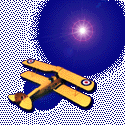

| F86 Sabre For Indoor Electric Ducted Fan |
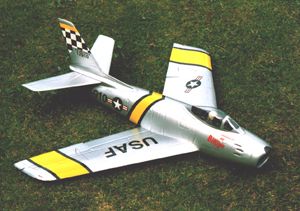 This
model, together with a Mig 15, is available from the USA - see web site
at www.fan-tasticmodels.com.
They retail at $70 but shipping to the UK might be a bit extra. If you
are interested, drop them an e-mail, my e-mails were responded to within
24 hours; they even shipped the model to my hotel whilst I was in Chicago.
This
model, together with a Mig 15, is available from the USA - see web site
at www.fan-tasticmodels.com.
They retail at $70 but shipping to the UK might be a bit extra. If you
are interested, drop them an e-mail, my e-mails were responded to within
24 hours; they even shipped the model to my hotel whilst I was in Chicago.
Both models have been
designed around the amazing miniature fan unit from GWS (GWS 50) and it
is a perfect fit in the model. The kit is moulded foam, similar to the
material in chip-trays. The fuselage shells came pre-joined and the wings,
tail and fin need to be cut out from their sheets; all the components
are exceptionally light. In addition there are a number of elegant ABS
mouldings and a very lightweight clear canopy, which can be fitted out
with the supplied pilot's head/shoulders. There is some wood included
in the kit - just for the traditionalist; the tiny horn for the all-moving
tailplane and the servo mounts  that
are laser cut together with the piece of 1/8th dowel for the wing leading
edge. These servo mounts push into ABS mouldings
that are then glued into the fuselage - very nifty idea. There is also
a sheet of high quality stickers to apply to the finished
model and these set it off a treat. Topping it all off is the fine instruction
booklet which contains numerous photographs and does a grand job of explaining
the construction process
that
are laser cut together with the piece of 1/8th dowel for the wing leading
edge. These servo mounts push into ABS mouldings
that are then glued into the fuselage - very nifty idea. There is also
a sheet of high quality stickers to apply to the finished
model and these set it off a treat. Topping it all off is the fine instruction
booklet which contains numerous photographs and does a grand job of explaining
the construction process
The model is a joy to put together and incorporates some very crafty ideas that are real weight savers; some of these will eventually appear on many indoor models I'm sure. For construction I used the left over glue from the GWS Tiger Moth; the instructions suggest using very small quantities of epoxy, but remember this is like adding lead to these models and the secret of good performance comes from making every effort to keep the weight down. I read somewhere that each additional gram reduces flight time by 1 second. I'm not sure if this is true but it is a good maxim to work to.
An alternative would
be Zap-a-dap-a-goo, which sticks anything to anything; remember whatever
you use, go sparingly and check compatibility on a piece of scrap foam
first. I promised Pete (the face behind this web site) that this wouldn't
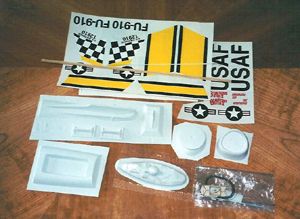 be
a traditional kit review as the instructions are perfect and are very
through. However, I will highlight what I thought were the novel aspects
of putting the Sabre together.
be
a traditional kit review as the instructions are perfect and are very
through. However, I will highlight what I thought were the novel aspects
of putting the Sabre together.
The wing leading edge is 1/8th dowel. This is simply attached to the foam and extends through the fuselage sides where an ABS moulded clip snaps onto them and anchors the lot in place; the wings are then permanently attached to the fuselage with your favourite glue. Niftily the strap to hold the battery in place hooks around this clip, very well thought out and does the job perfectly.
The tailplane is all-moving and this is achieved by bonding an aluminium tube to slots in each half; the characteristic slight v-tail of some versions of the Sabre is then easily obtained by gentle upward pressure on the tube.
The ailerons, which I hinged with diamond tape, are controlled by a closed loop system (all of which is supplied in the kit). This is a very clever way of getting these to work perfectly with no hassle and again no appreciable weight gain.
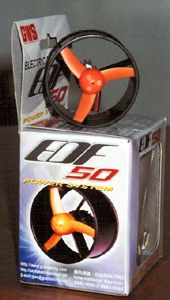 The
fan unit is attached to a moulded duct with masking tape and then pushed
into the fuselage as far as it will go. It is then sealed in place with
masking tape - hence easily removed with minimal disruption if need be
in the future.
The
fan unit is attached to a moulded duct with masking tape and then pushed
into the fuselage as far as it will go. It is then sealed in place with
masking tape - hence easily removed with minimal disruption if need be
in the future.
Loads of detail is moulded into the foam so that when you spray it and add the stickers the model comes alive. I sprayed mine with Humbrol silver enamel, which is foam safe, but if in doubt check on a bit of off-cut first.
Putting the Sabre together gave the impression that all aspects of the construction process had been very well thought out by the designers.
The radio components I used were as follows: -
- 2 GWS Pico servos (ailerons and all moving tail)
- GWS Pico Rx with micro crystal
- GWS ICS100 ESC (5 amp)
- Perkins 7 cell 250 mAh battery
All of these are readily available at most local model shops and are reasonably priced. The location of these as indicated in the instructions resulted in the CG being spot on. Control movements were set up as per the instructions. The total all up weight ready to fly was 179g (this is less than my Tiger Moth which came out at 210g), all good signs prior to the first flight.
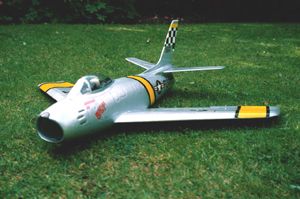 As
our indoor season has not started yet I chose a calm day (wind 7/10 mph
according to the Met Office) for the first outing. On the bench the fan
unit appeared to be putting out adequate thrust and from a gentle hand
launch the model went away with authority. Minor trim changes resulted
in the model flying tight circuits and figures of eight at low altitude.
This model will fly exceptionally well indoor, I have no doubts about
that but the elevator trim will likely alter from the outdoor setting
if the experience with the Tiger Moth repeats itself. Subsequent flights
have shown that a gentle hand launch is best, no need for javelin throws.
Flight times are in the region of 3 to 4 minutes and the speed is more
than adequate, not like a turbine model but enough to look impressive.
As
our indoor season has not started yet I chose a calm day (wind 7/10 mph
according to the Met Office) for the first outing. On the bench the fan
unit appeared to be putting out adequate thrust and from a gentle hand
launch the model went away with authority. Minor trim changes resulted
in the model flying tight circuits and figures of eight at low altitude.
This model will fly exceptionally well indoor, I have no doubts about
that but the elevator trim will likely alter from the outdoor setting
if the experience with the Tiger Moth repeats itself. Subsequent flights
have shown that a gentle hand launch is best, no need for javelin throws.
Flight times are in the region of 3 to 4 minutes and the speed is more
than adequate, not like a turbine model but enough to look impressive.
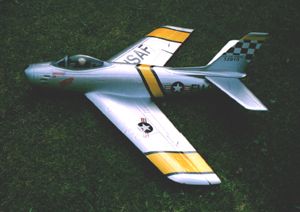 To
date I have had 12 flights on 3 different occasions and can't wait to
try it in the sports hall. It has gone well at all times and there have
been some exciting moments. When I taped the aerial along the wing, to
hide it away a bit more, I was getting some horrendous glitches. My advice
is to leave it dangling as there is no problem then. Two of the launches
have been exciting; one was with the nose pointing 45 degrees down (excuse
- hand stuck to model due to glow fuel on fingers) and the other at knife-edge
(excuse - slipped on grass because the field had just been cut and the
clippings not collected). The fact that I got away with them both speaks
volumes for the model - it is a real cracker and never fails to generate
attention.
To
date I have had 12 flights on 3 different occasions and can't wait to
try it in the sports hall. It has gone well at all times and there have
been some exciting moments. When I taped the aerial along the wing, to
hide it away a bit more, I was getting some horrendous glitches. My advice
is to leave it dangling as there is no problem then. Two of the launches
have been exciting; one was with the nose pointing 45 degrees down (excuse
- hand stuck to model due to glow fuel on fingers) and the other at knife-edge
(excuse - slipped on grass because the field had just been cut and the
clippings not collected). The fact that I got away with them both speaks
volumes for the model - it is a real cracker and never fails to generate
attention.
Several people have tried to buy it from me there and then, having seen it go, which is always a sign that you have made a good choice of model.
COMMENTS TO ACCOMPANY
PHOTOS
The Moulded
Foam Components
Fuselage (supplied pre-joined) and pressings for the wing, all moving
tail and fin. All very light weight and part of the secret to why the
model performed so well. Someone once told me that whenever you build
a model remember to add as much 'lightness' as possible - wise words.
Accessories
All the other bits and bobs. Moulded ABS components, clear canopy, bag
of ancillary pieces (close loop linkage, ply servo mounts etc.) and neat
stickers to finish it all off. Not shown (but of equal importance) are
the accompanying well-written instructions.
Electric Ducted Fan Unit
The neat GWS EDF 50 fan unit that provides more than adequate power to
propel the Sabre. This is a truly remarkable piece of kit and represents
excellent value for money, but run it of 7 cells for a bit of extra oomph.
Completed Model
Finished model
looking aggressive ready for its first combat mission.
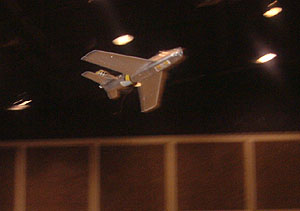
![]() Indoor Flight Report
Indoor Flight Report
The Sabre has flown indoors - see photo. If anything she goes better than
outside and appears to be much faster. I managed to fly circuits but couldn't
get in a figure of eight. I just ran out of airspace and slid sideways
into the wall.
Luckily their was no damage to the model, and the Sabre was up and flying around again straight away.
There was no trim change between indoor and outside and once away from a hand launch the Sabre could go around very well at half throttle. This allowed flight times of 5 mins plus which is more than enough as the level of concentration needed is a little more than that required with the GWS Tiger Moth. I managed about 6 flights in total and it generated a tremendous amount of interest.
Space needed is a minimum of 2 basketball courts - any smaller and it would be a real challange.| Technical Details - Super Sabre | |
| USA Manufacturer | Fan-Tastic Models (www.fan-tasticsmodels.com) |
| Aircraft Type: | Scale Indoor electric ducted fan |
| RRP | $70 + p&p |
| Wingspan | 22 inches |
| Weight | 7.25 - 7.75 ozs (179g in review model) |
| Length | 22 inches |
| Number of Channels: | 3 Channel Radio / 2 Servos + ESC |
| Control Functions: | Ailerons, Elevator, Throttle (ESC) |
| Motor/Fan | GWS EDF-50 |
| Battery Pack: | 7 cell 250 mAh battery |
| Likes | Dislikes |
|
|
Please
mention 'Flying Sites' when contacting
Fan-Tastic
Models
| Info Panel |
|
F86
Sabre
Fan-Tastic Models |
| Comments: A really head turning model, especially when flown indoors! |
| Price: $70 + p&p |
| See Technical Details Below |